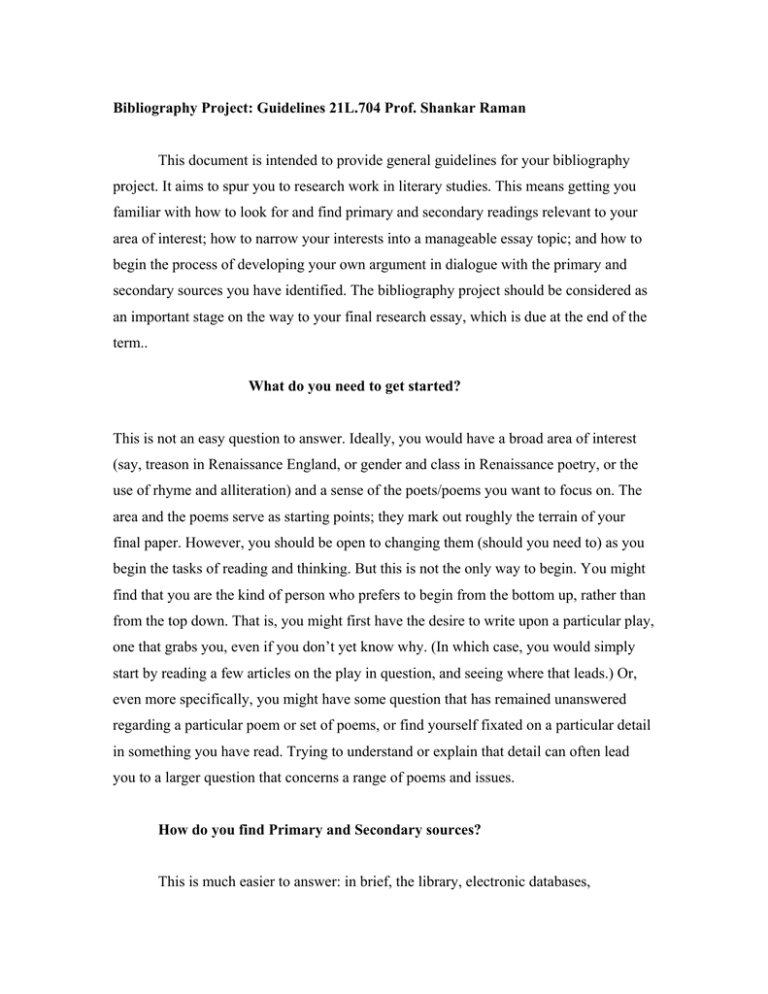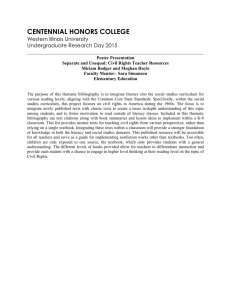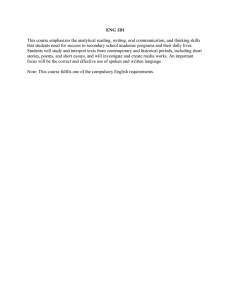Bibliography Project: Guidelines 21L.704 Prof. Shankar Raman
advertisement

Bibliography Project: Guidelines 21L.704 Prof. Shankar Raman This document is intended to provide general guidelines for your bibliography project. It aims to spur you to research work in literary studies. This means getting you familiar with how to look for and find primary and secondary readings relevant to your area of interest; how to narrow your interests into a manageable essay topic; and how to begin the process of developing your own argument in dialogue with the primary and secondary sources you have identified. The bibliography project should be considered as an important stage on the way to your final research essay, which is due at the end of the term.. What do you need to get started? This is not an easy question to answer. Ideally, you would have a broad area of interest (say, treason in Renaissance England, or gender and class in Renaissance poetry, or the use of rhyme and alliteration) and a sense of the poets/poems you want to focus on. The area and the poems serve as starting points; they mark out roughly the terrain of your final paper. However, you should be open to changing them (should you need to) as you begin the tasks of reading and thinking. But this is not the only way to begin. You might find that you are the kind of person who prefers to begin from the bottom up, rather than from the top down. That is, you might first have the desire to write upon a particular play, one that grabs you, even if you don’t yet know why. (In which case, you would simply start by reading a few articles on the play in question, and seeing where that leads.) Or, even more specifically, you might have some question that has remained unanswered regarding a particular poem or set of poems, or find yourself fixated on a particular detail in something you have read. Trying to understand or explain that detail can often lead you to a larger question that concerns a range of poems and issues. How do you find Primary and Secondary sources? This is much easier to answer: in brief, the library, electronic databases, inter-library loan, and -- once you have begun your reading -- the footnotes in articles or books you are reading. The electronic databases listed below are all available through VERA. The first place to search (by play, author, title, keyword, or subject) is the MLA database: this will generate a large number of citations of secondary articles and book on the play or topic. Go through them, looking at the titles, and (if necessary) at the brief description of topics covered by the article, deciding which ones might be relevant, and marking those. The MLA database will also indicate which ones are available at MIT. Those that are not can be directly requested through Inter-Library Loan (ILL) from the site itself. ORDER THOSE THAT YOU NEED IMMEDIATELY, even if you are not planning on reading them right away, since the time lag between ordering and receiving is unpredictable. The ones available at MIT, you get yourself. The next places to look are JSTOR and Project Muse. These databases cover selected years for a selected number of journals. The advantage to these is that you get not just the citation, but the articles themselves, which are downloadable in pdf format. For primary sources, EEBO is your place---a database that allows you to read online or download and print almost any book printed in England between 1475 and 1700. Of course, you probably shouldn’t go to EEBO right away, since it is much harder to figure out which primary texts are useful for your work. In general, go to the primary texts through the secondary texts: use the footnotes of articles or books you have read to get a sense of which primary texts would be useful for your work. Then, start reading, taking notes, and thinking as you read. And read and reread the play(s) you want to write about as well! What is an Annotated Bibliography? Your task is to identify primary and secondary texts relevant to your project. This means that you will have located and read more texts than you actually describe in your bibliography (the ones you don’t should be mentioned, too, but a full citation is sufficient to take care of them). As you read, decide on which articles, books, or portions of books are likely to be useful for your research paper. Take notes on these as you read. And then, after you’ve read each one, write up a brief summary of its argument or main points in as concise and coherent a manner as you can. Try and keep the description brief---in general, aim for 1/3 page single-spaced (or less) per article/chapter. Remember, however, that I should be able, upon reading the summary, to have a sense of what the article was about, and why you chose to summarise it. The annotated bibliography is essentially an alphabetical list of references (primary and secondary), in each case followed by a paragraph or two summarising the text in a way that suggests its relevance for your research paper. (As I have said above, sources that are only marginally useful may simply be listed in the bibliography without this accompanying summary). With primary texts, in addition to the brief summary of the relevant sections or an overview of the relevant parts, you probably want to excerpt a couple of quotations that you may use in your final paper. (In general, as you read, it is a good idea to maintain a file where you simply enter quotations from secondary and primary texts that you may use in the research essay. This will save you a lot of time in the long run.) Finally, write a page or two in which you try your best to synthesize the material you have read, and sketch the direction that you expect your paper to take. In other words, your bibliography should be accompanied by a brief prospectus or plan for the final paper. Now, when you actually write the paper, you may find yourself deviating substantially from the prospectus. That’s fine. The prospectus forces you to think about what you have read, draw connections, and bring things together. It is not intended as the final word. Finally, I offer you some questions to get you started. These are simply to give you a sense of the kinds of things one can do. You are by no means required to use one of them as the basis for your essay: 1. It has often been said that the Renaissance sees the emergence of a modern notion of the self. Think about the ways in which one or more of the poets you have read explore and create selfhood, personhood, individuality. 2. How does Marvell, in his Mower Poems, “The Garden,” and “Appleton House” use the genre of pastoral. To what ends does he direct the genre? 3. The sixteenth and seventeenth centuries a transformation in an understanding of the body. In what ways can such changes be seen in the poetry of the period? If not, why not? 4. The same question as the previous one, but with a different subject: the soul. How do such poets as Marvell and Donne approach the relationship between body and soul? 5. Are the poets you have read this term uniformly misogynist? How does the figure of the woman work in one or more of the poets you have studied? And so on.





